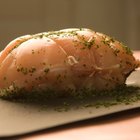Contrary to the implication of the name, Boston butt isn't actually a rump roast; this low-cost, fatty cut comes from a hog's shoulder. In Revolutionary War times, cheap pork cuts were kept in barrels called butts, probably accounting for the name. Although brining offers the most benefit to lean cuts, it enhances the finished product when preparing a Boston butt, too. Soaking the meat in a saltwater solution adds moisture to it, so it experiences less drying out and shrinkage due to water loss during cooking. Brining also offers an opportunity to impart more flavor into the pork.
Select a nonreactive food-safe container that's big enough to soak the Boston butt in, with the meat completely submerged. With the notable exception of stainless steel, most pots and pans are reactive, so they aren't suitable; glass, ceramic, plastic and stainless steel are appropriate choices for brining.
Fill the container with enough liquid to immerse the Boston butt. This can be all water, water mixed with another liquid, or another liquid altogether. If choosing something to use with or instead of water, pick something with a flavor you want to impart into the pork. Wines, beers, teas, vinegars, fruit juices, stocks and soy sauce are all possibilities. The more you use, the stronger the flavor imparted.
Stir in about 1 1/2 cups of kosher salt or 2 cups of crystal kosher salt per gallon of liquid, with a spoon until it is fully dissolved. Table salt works, too -- but you must use non-iodized salt, which isn't usually what people have at home. If you do use non-iodized table salt, use only about 1 cup per gallon of liquid.
Season the brine with other ingredients, if you wish. Only water and salt are necessary, chemically speaking, for the brine to work, so other liquids and additional ingredients are optional, used purely to enhance the Boston butt's flavor. Consider a sweetener; use about 1/2 cup of sugar, brown sugar, syrup, honey or molasses per gallon of liquid. You can include complementary fresh or dried herbs and spices to taste, as well.
Immerse the Boston butt in the brine. Top it off with a little water or other liquid, as needed, if the meat isn't covered completely. Put it in the refrigerator for six to 12 hours. Discard the brine after use, as its high salt content precludes it from you using it as a sauce. Additionally, the brine has been contaminated by raw pork, so it is not safe for you to use the brine, and you must discard it.
Related Articles

How to Make a Good Brine for Pork
How to Brine a Goose

Brine for a Deer Ham

How to Brine Pork Loins

How to Do Corned Pork
How to Brine a Pheasant

How to Brine Pork Leg

How to Make Salt Brine

How to Brine a Turkey Using Orange Juice

Can You Slow Cook Just a Pork Loin or ...

How to Cook Pork Tenderloin in a ...

How to Cook Boneless Country Spare Ribs
How to Brine & Smoke Pork Belly

How to Soak Deer Meat in Baking Soda

How to Cook Pork Hamonado
How to Make a Brine for Quail

Does Soaking Elk Roast in Milk Do ...

Can I Substitute Salt Pork for Smoked ...

How to Cook With Pork Jowl

How to Cook Shredded Pork in a Pressure ...
References
Writer Bio
Eric Mohrman is a food and drink, travel, and lifestyle writer living in Orlando, Florida. He has professional experience to complement his love of cooking and eating, having worked for 10 years both front- and back-of-house in casual and fine dining restaurants. He has written print and web pieces on food and drink topics for Visit Florida, Orlando Style Magazine, CrushBrew Magazine, Agent Magazine, Dollar Stretcher Magazine, The 863 Magazine and other publications.